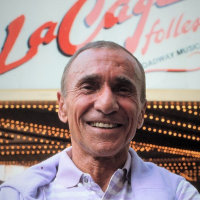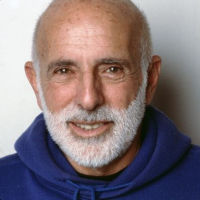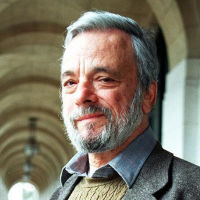10. Reinvention.
Apart from one or two of the really early things, Gypsy is the only musical in the course that I did not know
at all before beginning work on it: not a note, not a line, not even the story. A computer glitch made me have to stop
after watching the first act, and I had to wait a day before seeing the second. I found myself on tenterhooks wondering
how it would all work out. And this feeling was not confined to the intermission. At many other points in the show, I
found myself thinking that it would probably go in one direction, only to find that it went in quite a different one.
Does this make the show unique, then, or the first of its kind? It is hard to tell, since I have never approached any
other show with such an open mind. But it was enough to make me give up my original plan of setting this beside the other
Jule Styne showbiz musical I originally announced, Funny Girl, and concetrate entirely upon working out why
Gypsy itself made such a strong impression—if not unique, at least unique for me.
What is so unusual here is that these characters—especially the protagonist Rose Hovick, and her daughter Louise who would
eventually turn herself into the burlesque star Gypsy Rose Lee—have more than one dimension. You don't just take what they
are singing or saying, you wonder what is really going on in their minds. There is at least one number when Louise listens
to her mother without saying much, but you wonder what she is thinking and how this will affect her choices further down
the road. Gypsy introduced subtext to the American musical theater. I owe this point to the essay by Robert
W. Schneider in the book Fifty Key Stage Musicals (Amazon link),
but I'd like to think I'd have realized it for myself.
With most other musicals, I know at least one or two of the tunes in advance; I may have heard some of the lyrics; the
book—the actual play that strings all these together—comes a distant third. This is the first musical I think of predominantly
as a play. The script, by Arthur Laurents of West Side Story, would still be gripping in the straight theatre, except
that it is set in the world of vaudeville and that requires music. And Jule Styne certainly comes up with that music; time
after time, he provides powerhouse numbers for the performers to deliver, but I doubt you would want to hear a concert
selection of the tunes, as you do with Rodgers and Hammerstein or even West Side Story. Stephen Sondheim (also a
West Side alumnus) provides lyrics that dazzle when they need to, but they never set up a conflict between cleverness
and emotion. This is a "book show" if ever there was one. Even in the second act, which as usual has more dialogue than music,
you don't feel any shift of medium, because it is the human story that has been absorbing your attention all along. rb.
The handout above gives a brief synopsis of the story. If you need more, there is a 7-minute summary
here, illustrated with snippets from both movies of the
show and several stage performances, including the 2016 London production with Imelda Staunton that I am mainly going to
use. This summary comes from a long video essay called "The Twisted Accounts behind Gypsy," which goes into
some detail on the lives of Rose Hovick and her performer daughters June Havoc and Gypsy Rose Lee, but the later sections
might be better watched after attending the class. If you just want to know more about Gypsy Rose, try the nine-minute
video here.
The script, videos, and images will be posted immediately after class.
Q AND A
How did the original production with Ethel Merman end?
Someone asked this at the end of class, but the fact is I don't know. There are no video clips of this part of Merman's performance
and no audios of the dialogue. However, Stephen Sondheim writes: Yet the end of Gypsy is not entirely bleak. Louise comes out a star
and forgives her mother. There is hope for her. Rose does confront who she is in 'Rose's Turn.' There is a catharsis. It's not
Rodgers and Hammerstein, but you feel maybe the mother and daughter will come to an understanding and maybe triumph over Rose's
craziness and Louise's bitterness. I assume this applies to the first production; it is also true of the Rosalind Russell film.
The compilation with which I ended the class can be found here. The
Wikipedia article gives the following rundown of other endings:
Broadway revivals 1974 and 2008:
In these revivals, although the final dialogue scene remains, there is not a happy ending, but rather a bleak, sad one as all
hopes of reconciliation for Rose and Louise fall flat when Louise walks away, laughing sarcastically at Rose's new "dream."
The audience is then left with a somber Rose, whose dream of her own lit-up marquee slowly fades away to her unrealistic dreams.
Broadway revival 2003:
In the 2003 revival starring Bernadette Peters, the final dialogue scene remains, but leaves the ending open to more interpretation
from the audience. Louise walks through the stage door, with Rose following behind. Rose then turns to face the audience, a look
of sadness and longing on her face as she takes one last look at the empty stage. She pauses and slowly closes the door.
2015/16 London revival:
In the 2015 West End revival starring Imelda Staunton, Louise begins to walk out, and Rose catches up after waking up to reality.
Louise puts her arm around Rose as they exit together.
Broadway revival 2024:
In the 2024 revival starring Audra McDonald, Rose and Louise embrace and exit the stage arm in arm.
COMPLETE VIDEOS
The 1963 movie with Rosalind Russell is available for rent on
Amazon Prime.
Although this is probably the way most older people got to know the show, I have not used it, partly because Russell
does not do her own singing, but mainly because sixties Hollywood liked to display its stars with a certain glamor, and
neither in costume nor in manner is Russell allowed to get really down and dirty. Natalie Wood is a lovely Louise.
The 1993 made-for-tv movie with Bette Midler is currently available for free on
YouTube, though not in the best quality; it may also be rented
on Amazon Prime.
Although I chose to use the Staunton stage performance rather than a filmed version, I still recommend this. Midler
is the better singer and a surprisingly good actress. The only problem I have is that she tends to slip slightly out
of character when she sings, whereas Staunton never does (even to the occasional detriment of the music). The clips
show below, however, are separately available on YouTube.
The 2016 stage production with Imelda Staunton is also available free on
YouTube in pretty good quality. I trust I have made
sufficiently clear why I chose this as my go-to version. The clips in the list below are all cued to the specific
scenes we watched in class.
CLIPS
Everything shown in class is available on YouTube, plus a great deal more; there are also two
complete filmed versions that can be rented for about $4 at the links above. For the Imelda Staunton performance that I
mostly played, I have listed the individual scenes we watched in the order they appear in the show. I also added some
numbers from other celebrated performances, plus some additional documentary material—and this barely scratches the surface!
*Asterisks indicate items not shown in class.
| PRODUCTION SHOWN IN CLASS |
| |
Imelda Staunton, 2016 |
|
* Opening
* Rose and her father
("Some people")
* Newsboys
* Little Lamb
* Farmboys
* Tulsa/Louise scene
* Omaha station
("Everything's comin' up roses")
* Act 2 opening
* Backstage in Wichita
* Louise's strip montage
* Backstage at Minsky's
("Rose's turn")
|
| |
| OTHER PERFORMERS |
| |
Ethel Merman, 1959 |
|
* Everything's comin' up roses
(Perry Como show, not acted)
|
| |
Angela Lansbury, 1973 |
|
* Rose's turn
(reacting to video of younger self)
|
| |
Bette Midler, 1993 |
|
* Some people
* Everything's comin' up roses
* Together wherever we go
* Rose's turn
|
| |
Bernadette Peters, 2003 |
|
* Rose's turn
(Tony Awards)
|
| |
Patti LuPone, 2008 |
|
* Some people
(interview and talk-show performance)
* Everything's comin' up roses
(Tony Awards)
* Minsky's dressing-room dialogue
(not great quality)
* Rose's turn
(fan-shot, poor quality)
|
| |
Audra McDonald, 2024 |
|
* Trailer
|
| |
| COMPILATIONS |
| |
Multiple performers |
|
* Some people
(almost every Rose to date!)
|
| |
Final moments |
|
* My compilation shown in class
(Russell, Midler, LuPone, Staunton)
|
| |
| DOCUMENTARIES AND INTERVIEWS |
| |
Archival |
|
* The Real Gypsy Rose Lee
(9-minute bio)
|
| |
Video essay |
|
* The Twisted Accounts behind GYPSY
(hour-long investigation)
|
| |
Audra McDonald |
|
* Interview: Rose the Tornado
(discusses other interpretations)
|
| |
|
|
|
|
|
| IMAGES |
The thumbnails below cover the slides shown in class, though
there may be a few small discrepancies. Click the thumbnail to see a larger image.
Click on the right
or left of the larger picture to go forward or back, or outside it to close. |
 | |
 | |
 | |
 | |
 | |
 | |
 | |
 | |
 | |
 | |
 | |
 | |
 | |
 | |
 | |
ARTISTS
Here are brief bios of the artists, composers, and writers considered in the class, listed in order of birth.
 |
Jule Styne, 1904–95. English-American composer.
Born in London to Ukrainian emigrant parents, Styne moved with them to Chicago when he was 8 and immediately started taking piano lessons. He proved to be a prodigy and was appearing with major symphony orchestra by the time he was 10. In his later career, he was a band performer, Hollywood vocal coach, and composer of over 1,500 songs and musicals such as Gypsy (1959) and Funny Girl (1964). His first name is pronounced in two syllables.
|
 |
David Merrick, 1911–2000. American producer.
Merrick, who was born David Lee Margulois in St. Louis, abandoned his career in law to become a theatre producer, and became one of the most successful in the business, often competing against himself at the Tony Awards. He was equally active in presenting stage plays (Look Back in Anger, Marat/Sade, Rosenkrantz/Guildenstern) and musicals (Gypsy, Oliver!, Hello Dolly). He was married 6 times to 5 different women.
|
 |
Arthur Laurents, 1917–2011. American writer and director.
Laurents, who was born Arthur Levene in NYC, began a varied career in radio, film, and theater after graduating from Cornell. For example, he was the screenwriter for Alfred Hitchcock's Rope (1948), book-writer for West Side Story (1957) and Gypsy (1959), and director of La Cage aux Folles (1983). He won two Tony Awards, a Golden Globe, and several Oscar nominations.
|
 |
Jerome Robbins, 1918–98. American choreographer and director.
Beginning his career as a dancer and later choreographer with the American Ballet Theatre, Robbins later joined forces with Balanchine in the New York City Ballet. While he created numerous ballets in the classical tradition, his career on Broadway and in film is at least as important, including his work on West Side Story in both media.
|
 |
Stephen Sondheim, 1930–2021. American composer and lyricist.
A protégé of Oscar Hammerstein's, Sondheim made his Boadway debut in 1957 as lyricist for West Side Story and Gypsy, but he soon began his own string of musicals, writing the music as well as the words, including A Funny Thing Happened on the Way to the Forum (1962), A Little Night Music (1973), and Sweeney Todd (1979). Often dealing with non-traditional subjects, these and others largely redefined the Broadway in the later 20th century.
|
• Return to top
• Return to index




















